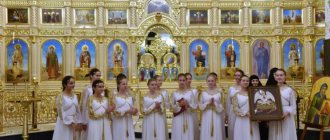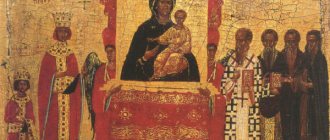About Orthodox worship
The verbal and melodic part of Orthodox worship consists of church singing and reading. The difference between them is only in melodic breadth. Church singing is essentially a melodically expanded and embellished reading, and reading is the same singing, shortened in melody according to the content of the text and the requirements of the Charter. At the same time, the liturgical melody does not simply accompany the sacred text, but reflects its content and complements it, conveying what cannot be expressed verbally. The 19th century musicologist V.F. Odoevsky said that “... our fathers called church singing not music, but a verbal melody.” The melody is prayerful, theological, simple, but great wisdom is hidden in this simplicity. She is majestic, but not proud, calms the soul, but does not relax her, stern, but not merciless, mournful, but not tear-jerking. There is neither a complete major nor a minor in it - just as on earth there is neither perfect joy nor hopeless sorrow. Our church singing was created by saints and devotees of piety, for whom melody was the voice of the spirit, and not a subject of exercise in art. The Fathers of the Church created texts and melodies that are organically connected with the content, and they also created the very rules of church singing. Moreover, this charter determines not only the order and sequence of performance of chants during the service, but also concerns the nature of the melodies themselves and the method of their performance.
The basis of any melody of Orthodox chant is the psalmody
- a short melody that consists of three or four repeating tones.
It can be expanded in various ways. Psalmody itself in its pure form is what we call liturgical reading, which the holy fathers call singing
, thereby indicating their chanting performance.
The extended psalmody - the melody of Orthodox chants - comes in two types: “similar”
and
“self-according”
. According to the rules, the melody is similar, simpler, and the melody is self-consonant - wider. Samoglas have their own melody, characteristic of them, and do not serve as a model for other chants of the same voice. Similar ones are performed according to a certain musical pattern; this pattern is called “self-similar.” Therefore, always with a stichera that is supposed to be sung in a similar manner, the initial words of the self-similar, serving as a model, are indicated. (For example, voice 8 is similar to “O glorious miracle...”).
In the church charter you can also find instructions on the nature of the performance of chants. For example, “Most Honest...” is supposed to be sung “with great voice”, “Lord have mercy” at Little Vespers and Midnight Office - “in a meek and quiet voice”, etc. There are such instructions: “slowly and inertly” (loudly and slowly), “sweetly singing”, “soon”, etc.
The liturgical melody should be pure, dispassionate, peaceful, “spiritual.” Orthodox liturgical singing is, first of all, the word
, only colored by musical sound.
Church melodies of Catholicism and Protestantism are beautiful musical pictures that caress the ear and touch the weak sides of the human soul. But this beauty cannot be called truly spiritual. Just as the most brilliant painting on a religious subject differs from an icon, so the sensual beauty of these chants differs from the truly spiritual, sober beauty of the statutory Orthodox chants. Unfortunately, this spirit of sensuality began to penetrate into Orthodox chants, especially in the 19th century. Church composers began to create melodies for Orthodox chants that had nothing in common with the Orthodox tradition and the rules of worship. These chants affect our sensuality and seem beautiful. But we must understand that these melodies belong to a different genre, they contradict the charter of the Church and are alien to the spirit of Orthodox worship. Saint Ignatius (Brianchaninov) wrote about this this way: “The works of the newest composers distort the mood of their spirit, the mood is Western, earthly, spiritual, passionate or cold, alien to the feeling of the spiritual... Those who worked in them brought their own character into some hymns, destroying the completely church character” [ 1]. I.A. Gardner speaks about this: “... semi-statutory chants and their choral harmonizations almost completely replaced the statutory correct chants in choral use in the 19th century... A very large part of the liturgy of the modern Russian Church is represented by non-statutory
,
non-canonical
liturgical singing” [2] (t i.e. free choral compositions based on liturgical texts).
One of the main principles of the charter is belonging to one or another voice, to the system and the principle of osmovosiya. In this sense, polyphonic harmonizations of statutory vocal chants can still be recognized as statutory singing, although choral polyphonic singing according to the Western model does not belong to the tradition of the Orthodox Church. It was only approved for liturgical use (in the Russian Church in the 17th century).
Singing in the Church should also be orderly, edifying, and grace-filled. “...you need to sing to the Lord not with your voice, but with your very life,” said the Monk Barsanuphius of Optina. “In the Holy Scriptures, life in Christ is called singing. “The Lord is my strength and my song and he is my salvation” (Ps. 117:14), “... I sing to my God until I am” (Ps. 145: 2).” The canons of the Church prohibit deliberately loud singing: “It is not proper... to compel nature to cry” (174 rule of the Nomocanon). The strength of the sound must be limited by the limits of the natural loudness of each singing voice, otherwise such singing is called by the canons of the Church “disorderly cry.” No one voice should stand out. Saint Philaret of Moscow said that “a possible strengthening is already a cry.”
The distribution of chants according to their content is governed by the law of octoharmony, which is the basis of the liturgical singing of the Orthodox Church. The organizer of the church octogeny is St. John of Damascus. All chants are divided into eight voices according to the content of their text. Each of the voices is a certain tune, a certain musical basis for chants. Each voice has its own internal content.
The idea of octagonism underlies the universe. The Lord created the world in six days and “blessed the seventh day and sanctified it, for on it He rested from all His works, which God began to do” (Genesis 2:3). The eighth day, according to the interpretation of the holy fathers, is the day of the Lord, one and endless, the Day of the future age (the Kingdom of Heaven). This idea is reflected in various aspects of church life. For example, octal harmony as the basis of liturgical singing. Most of the great holidays are celebrated in the Church for seven days and are “given away” on the eighth day.
The principle of octopus was at one time adopted by the Russian Church from the Greek Church and is the musical basis of worship. However, the concept of octagonism in the Greek tradition differs from ours. For the Greeks, voice is a mode, a tonality. In the Russian tradition, a voice is a certain melody, fixed once and for all. Each voice has, in addition to its characteristic tonality, mode, also the most common melodic turns in this voice - chants. There are only eight voices. Four basic (athentic) - 1,2,3,4 and four derivatives (plagal) - 5th to 1st, 6th to 2nd, 7th to 3rd, 8th to 4- mu. Each of the plagal voices completes and deepens the content of the corresponding authentic voice.
Each voice begins on Sunday and continues until Saturday inclusive, communicating to the entire week the grace of the past Sunday. This voice dominates the worship service throughout the week.
We are now accustomed to the fact that stichera, kontakia, irmos, prokeimnas, and alleluia are sung in voices. But, with a few exceptions, almost all hymns of the Orthodox service, including unchangeable ones, are sung in a certain voice. For example, the Opening Psalm and “Blessed is the Man” at the beginning of the All-Night Vigil are required by the Rule to be sung in the 8th tone. “Quiet Light” is sung in all eight voices. The Great Doxology, “Most Honest”, Greatness - should be sung in the 6th tone. The “Cherubic Hymn” was sung by St. John of Damascus himself in the 6th tone. The same voice is set for “Now the Powers of Heaven” and “Thy Last Supper this day.” “Let all human flesh be silent” - 8th tone. According to the Rule, the Creed and the Lord's Prayer are not sung, but read. The tradition of singing the Creed came to Russia in the 16th and 17th centuries from the West. The famous melody of the Eucharistic canon consists of one line of the 2nd voice, intertwined with a melodious recitative.
Let us conclude with a brief description of the voices. You will find a more complete and reasoned analysis in the book of Archpriest Boris Nikolaev “Znamenny chant and hook notation as the basis of Russian Orthodox church singing” [3].
1 voice
- luminous, majestic, sung easily and swiftly, soars to Heaven, capable of attuning the soul to sublime feelings. This is the voice of heavenly beauty, Divine greatness and glory, spiritual joy. This is the Easter voice. The service for the feast of Holy Easter is composed in the 1st tone and in the 5th tone parallel to it.
2 voice
- tender, touching, conducive to love, tenderness, compassion, reflecting the subtlest experiences of the human soul. First of all, this is the voice of Holy Saturday. This same voice and the parallel 6th voice dominate in the chants of funeral services. The 2nd voice is the voice of “transition,” reflecting the transitional state (pre-celebration, the exodus of the soul from the body, the transition from temporary life to eternal life).
3 voice
- smooth, quiet, sedate, but at the same time firm, courageous. This voice has the smallest number of chants and is in penultimate place in terms of the number of chants placed on this voice. The chants of the 3rd tone contain reflections on the secrets of the Heavenly World, and also reflect heavenly joy, light and praise. So, for example, the Sunday troparion of the 3rd tone depicts the Resurrection of Christ as a source of universal joy.
4th voice
- fast, solemn, delightful, exciting to fun and joy. The voice of bright, brilliant triumph, but not triumph, as in the 1st voice. The fourth voice is not without a hint of repentance, a reminder of human sinfulness.
5 voice
-
plagal to the 1st
, is its completion and deepening. The majestic procession ends with deep worship. In the hymns of the 5th tone one hears a call to worship (for example, the Sunday troparion - worship of the Resurrection of Christ), as well as a bright greeting: “Rejoice!” (self-similar to “Hail, Life-Giving Cross”, etc.) By the nature of the melody, the 5th voice is both a little sad and joyful.
6th voice
-
plagal to the 2nd
. The melody of the 6th voice is very sad, conducive to contrition for sins, crying, but at the same time filling the soul with reverent tenderness. This voice conveys deep sorrow, dissolved by heavenly consolation. If the 2nd voice is the voice of exodus, then the 6th voice is the voice of burial. The canons of Matins on Maundy Thursday, Good Friday and Great Saturday, and the canon of burial of the laity are based on this voice. It is also a voice of deep repentance, contrition for sins. The Great Penitential Canon of St. Andrew of Crete is set to the 6th tone. Many hymns in honor of the venerable fathers and saints are also sung in the 6th tone.
7th voice
-
plagal to the 3rd
. The most meager in the number of chants and musical lines. The Greeks call this voice “heavy.” His character is important, courageous, as if breathing in cheerfulness, hope, and courage. The melody and lyrics of the 7th tone are majestic and simple, but behind this simplicity lies something deep, great and incomprehensible. The chants of the 7th tone speak a lot about the future age, unknown and incomprehensible, about the Heavenly Jerusalem.
8th voice
-
plagal to the 4th
. The voice of fullness, perfection, height, royal, completing the earthly and pointing to the fullness and perfection of the Heavenly. Also, this is a voice of high praise, exclamation (“Oh the glorious miracle”, “He rejoices in You”, “What shall we call you, saints”). At the same time, the melody of the 8th voice is somewhat sad and touching. In the 8th tone the chant “Open the doors of repentance, O Giver of Life...” is supposed to be sung.
Features of church singing
Church singing and reading are the most important components of worship, and the difference between them lies only in melodic breadth. This is quite obvious, since Orthodox singing is nothing more than reading? expanded and based on a specific musical basis. At the same time, is reading itself singing? melodically abbreviated in accordance with its content and the requirements of the Church Charter.
In church singing, the task of the melody is not to aesthetically embellish the text, but to more deeply convey its internal content and reveal many features that cannot be expressed in words. In itself, it is the fruit of the inspired labors of the holy fathers, for whom hymns were not exercises in art, but a sincere expression of their spiritual state. They created the Charter of Chants, regulating not only the sequence of performance, but also the nature of certain melodies.
Modern words that remember their ancestor
We promised the discovery of new meanings of old, well-known words. So, after we understand what a voice is, it’s time to turn to studying the obvious. Of course, not everything will be on our list, but only the most important and necessary. So, the list is as follows:
- proclaim;
- announce;
- disclose;
- vowel;
- consonant;
- unspoken;
- loud; loud
- exclamation;
- publicity;
- disagreement.
As you can see, words obey a certain principle. Verbs come first, then adjectives, and nouns complete the list. If we mentally, for example, replace “voice” with “voice,” then some meanings will immediately become more obvious. For example, a disagreement is two people who voted for different points of view. Glasnost is a phenomenon in which a person can talk about everything that worries him, that is, in a full voice. Moreover, let the reader not think that we are presenting our conjectures as some kind of linguistic truths. This is simply thinking based on open knowledge. The reader can also try to practice this with the rest of the list items. By the way, there is only one adverb with a similar root - “unanimously”, so we did not include it in the list, but gave it separately. It becomes clearer and clearer what voice is. Let's move on to the interpretation of phrases with the object of study.
Completing the list of octagonism
Less often in Orthodox churches you can hear chants set to the seventh tone. Greeks? authors of the law of octagonism? They called it “heavy”. The character of the chants performed based on it is important and courageous, which fully explains the name given to it. Is there a whole world hidden behind the external simplicity of these melodies? deep, great and incomprehensible. This is a kind of narrative about Heavenly Jerusalem and the Future Age.
Having listened to such high examples of church singing as “In You He Rejoices...” and “O Glorious Miracle...”, one can easily get an idea of what a voice is. Eighth voice? the last one, it completes the list of elements that make up octovosonance. It is full of royal heights, perfection and calls to trust in the Beginningless Father, who created the visible and invisible world. At the same time, listening to him, it is impossible not to notice a certain shade of sadness caused by the thought of one’s own sinfulness.
How to discover the voice of the people?
The voice of the people is something more ordinary and well-known. Simply put, it is people's opinions on various topics. Methods that give people the opportunity to speak out are widely known: opinion polls, interactive television, and voting. There are also less peaceful ways of expressing the opinion of the people - these are revolutions and other social cataclysms. When they happen, people don’t just talk, they shout about their rights and needs.
In this same context, it is very interesting to ask the question, do the voice of God and the voice of the people coincide? In Latin there is even a proverb “vox populi vox Dei”, that is, “the voice of the people is the voice of God.” There is also a translation that is more familiar to us, but we would like the reader to understand for himself what it is. To do this, you just need to replace “voice” with “voice”. We now know that voice is a synonym for “voice”.
Regarding the main question, whether God's voice coincides with man's, opinions differ. Conformists believe that it coincides, nonconformists have a different opinion. Let's just say that when the people begin to be indignant and revolt, this clearly says: there is a serious misunderstanding between the people and those who govern them. When it is not about politics, the problem seems even more insoluble. Because if we take opinion polls as an example, it is impossible to ensure that the whole country participates. Therefore, surveys are largely a matter of chance. This is such a difficult topic about the voice of the people. But in any case, there will be those who are dissatisfied with something, and those who are happy with everything. Also, there is always a layer of people between these two extremes who do not experience any feelings at all, do not evaluate their situation in any way, taking it for granted. In human life there is something to fix and something to leave alone, it is an eternal story.
Yes, it’s still interesting what the analysis of one single word can lead to, but initially we had a more than modest goal - to talk about the meaning of the word “voice”.
Origin
The etymological dictionary indicates that the word came to us from the Old Church Slavonic language. The common Slavic word that gave life to the object of our study is gols. It is related to the word “verb” - the same base. There is also an interesting story with the “verb”. Now by this word we understand only a certain part of speech, but earlier it was used in the meaning of “word”, “speech”, and in some contexts the meaning of the definition was similar to the modern actions “speak”, “pronounce”. Remember, for example, the well-known phraseology “through the mouth of a baby the truth speaks.” We don't need a dictionary to understand the meaning of an expression, right?
Fifth and sixth plagal (auxiliary) voices
The fifth is the plagal voice. Its significance is very great: it serves to give greater depth and completeness to chants performed on the basis of the first voice. His intonations are filled with a call to worship. To be convinced of this, it is enough to listen to the Sunday troparion to the Resurrection of Christ or the greeting “Rejoice.” Both of these works carry shades of sadness and joy at the same time.
The sixth voice is auxiliary to the second and emphasizes sadness, which induces repentance for sins committed and at the same time fills the soul with tenderness and hope for the Lord's forgiveness. This is sorrow dissolved by consolation. As already mentioned, the second voice gives a feeling of transition to another world, and is therefore filled with light, while the sixth is more associated with burial. For this reason, chants of the second half of Great Week are sung on its basis.
The meaning of the word “voice” as applied to church singing
In the Russian Orthodox Church, liturgical singing is based on the principle of “octophony,” the author of which is St. John of Damascus. According to this rule, all chants are divided into eight voices in accordance with their content and the semantic load contained in them. Each of them is characterized by a strictly defined tune and emotional coloring.
The law of octagonism came to the Russian Orthodox Church from Greece and received a certain creative reworking from us. This was expressed in the fact that, unlike the Greek original, where church voices serve to designate only mode and tonality, in Rus' they mainly designate a certain melody assigned to them and not subject to change. As already mentioned, there are only eight voices. Of these, the first four are basic (athenic), and the subsequent ones are? auxiliary (plagal), whose task is to complete and deepen the main ones. Let's look at them in more detail.










